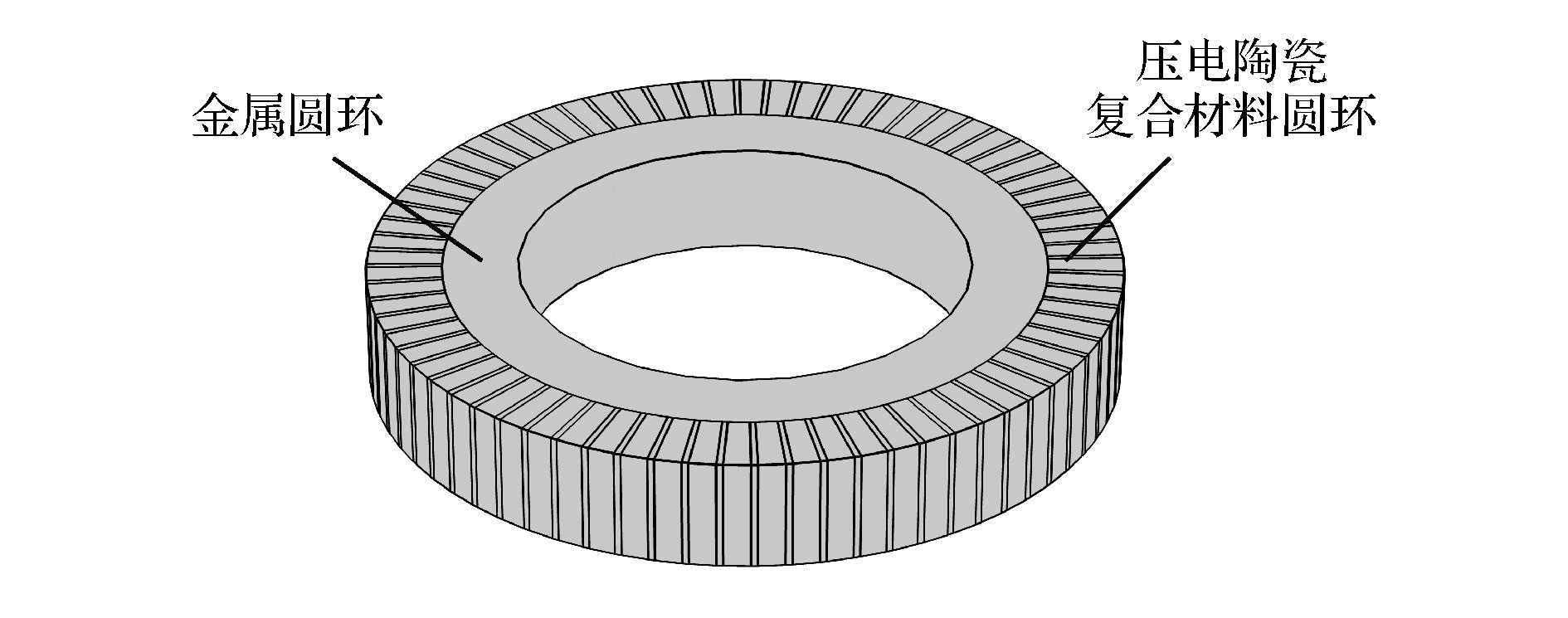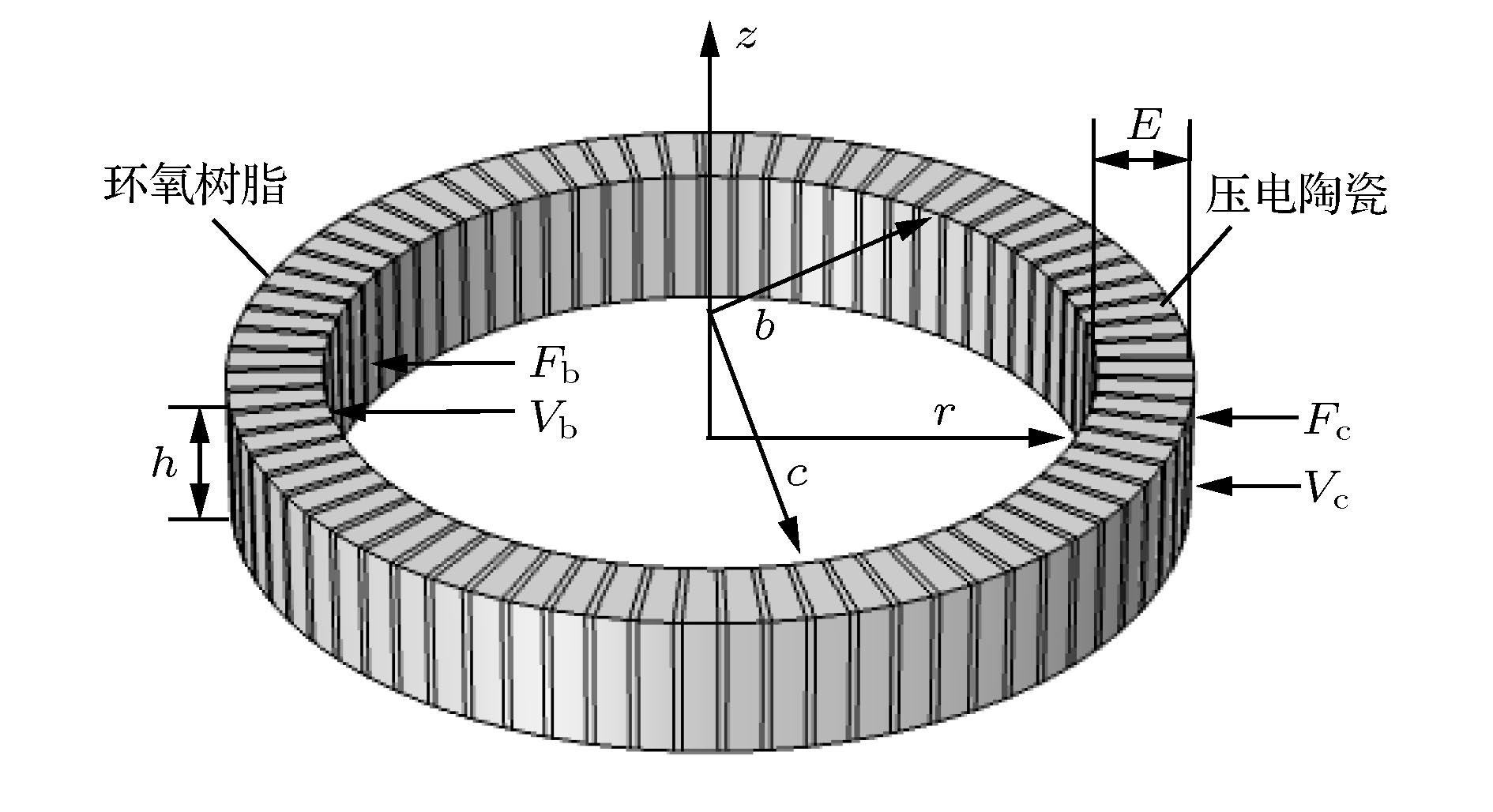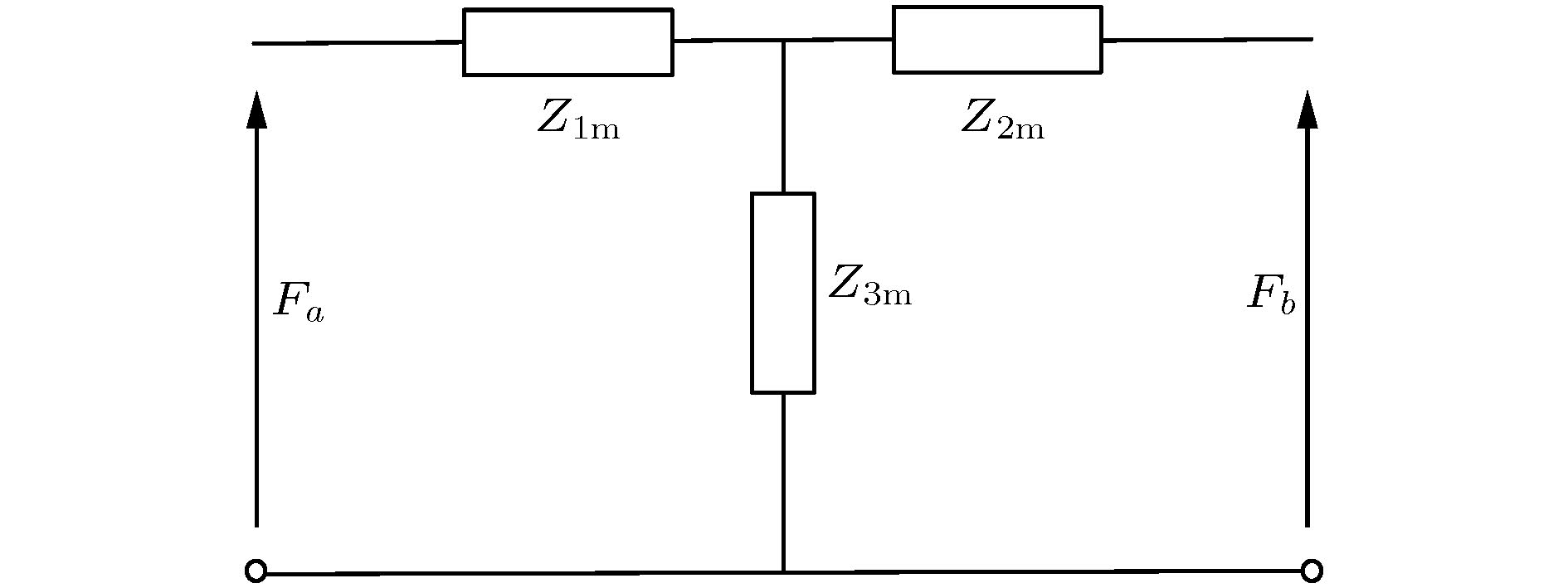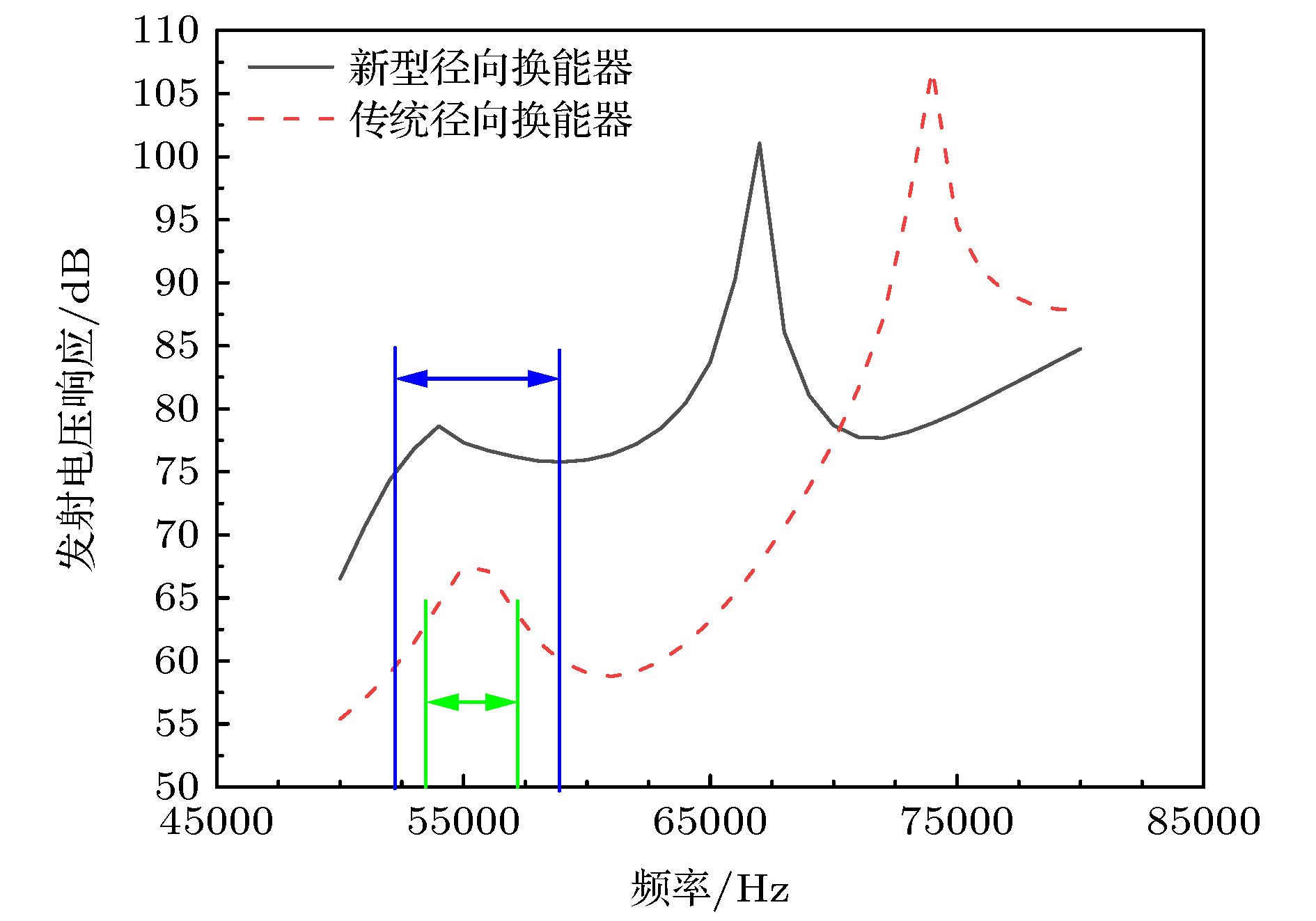-
本文提出了一种基于2-2型压电复合材料的新型宽频带径向振动超声换能器, 它主要由内金属圆环和外压电陶瓷复合材料圆环组成. 首先利用Newnham串并联理论和均匀场理论推导了2-2型压电复合材料的等效参数; 其次利用解析法得到了金属圆环和径向极化压电复合陶瓷圆环径向振动的机电等效电路; 最后得到了换能器的六端机电等效电路, 从而得到了换能器的频率方程. 接着分析了换能器共振频率和反共振频率以及有效机电耦合系数与几何尺寸、两相体积占比的关系, 采用仿真软件对新型换能器的径向振动进行了数值模拟. 结果表明, 利用解析法得到的共振频率和反共振频率与数值模拟结果吻合较好. 此外, 对换能器在水下的辐射声场进行了仿真研究, 结果表明新型复合材料径向换能器相比传统纯陶瓷径向换能器, 发射电压响应幅值更大, 工作带宽提高接近一倍, 声匹配更佳.Radial vibration transducer has the advantages of large radiation area, high radiation efficiency, uniform radial radiation, and wide range of action. Therefore, it is widely used in the technical fields of ultrasonic liquid treatment such as underwater acoustics, ultrasonic degradation and sonochemistry. On the other hand, the 2-2 piezoelectric composite material is one of the most commonly researched piezoelectric composite materials with the best development prospects. Compared with traditional pure piezoelectric ceramics, this new type of material has the advantages of low impedance, low mechanical quality factor, and frequency bandwidth. Therefore, in this paper we propose a new broadband radial vibration ultrasonic transducer based on 2-2 piezoelectric composite material, which is mainly composed of an inner metal ring and an outer piezoelectric ceramic composite ring. First, the Newnham series-parallel theory and the uniform field theory are used to derive the equivalent parameters of the 2-2 piezoelectric composite material. Second, the radial vibration of the combination of the metal ring and the radially polarized piezoelectric composite ceramic ring are analyzed by the analytical method. The six-terminal electromechanical equivalent circuit of the transducer is obtained, and the frequency equation of the transducer is also obtained. And then the relationship between the resonant frequency and anti-resonant frequency of the transducer, as well as the effective electromechanical coupling coefficient, geometric size, and two-phase volume ratio are analyzed. It is concluded that in order to obtain higher electromechanical conversion efficiency, the design of the transducer radius ratio should be as close as possible to 0.35. Although the higher proportion of polymer phase will lead the electromechanical conversion efficiency to decrease, it can also bring better acoustic matching ability. Therefore, the lower proportion of polymer phase can be selected in the transducer design. The finite element method is used to numerically simulate the radial vibration of the new transducer. The results show that the resonance frequency and anti-resonance frequency obtained by the analytical method are in good agreement with the numerical simulation results. In addition, the acoustic field of the transducer under water is simulated numerically. The results show that compared with the traditional pure ceramic radial transducer, the new composite radial transducer has a large emission voltage response amplitude, the working bandwidth is nearly doubled, and the acoustic matching is better.
-
Keywords:
- composite material equivalent parameters /
- radial vibration /
- bandwidth /
- acoustic matching
[1] 刘世清, 麻磊磊 2020 陕西师范大学学报 (自然科学版) 48 60
Liu S Q, Ma L L 2020 J. Shaanxi Normal Univ. (Nat. Sci. Ed.) 48 60
[2] 路德明 2001 水声换能器原理(青岛: 青岛海洋大学出版社) 第347−353页
Lu D M 2001 Principle of Underwater Acoustic Transducer (Qingdao: Qingdao Ocean University Press) pp347−353 (in Chinese)
[3] 梁召峰, 莫喜平, 周光平 2011 声学学报 36 369
Liang Z F, Mo X P, Zhou G P 2011 Acta Acustica 36 369
[4] 林书玉 2007 陕西师范大学学报 (自然科学版) 35 254
Lin S Y 2007 J. Shaanxi Normal Univ. (Nat. Sci. Ed.) 35 254
[5] 林书玉 2008 声学技术 27 605
Lin S Y 2008 Tech. Acoust. 27 605
[6] 林书玉 2004 超声换能器的原理及设计 (北京: 科学出版社)第15页
Lin S Y 2004 The Principle And Design Of Ultrasonic Transducer (Beijing: Science Press) p15 (in Chinese)
[7] 薛术 2015 硕士学位论文 (西安: 西安电子科技大学)
Xue S 2015 M. S. Thesis (Xian: Xidian University) (in Chinese)
[8] Smith W A 1991 IEEE Trans. Ultrason. Ferroelectr. Freq. Control 38 40
 Google Scholar
Google Scholar
[9] Smith W A 1990 IEEE 1990 Ultrasonics Symposium Honolulu, HI, December 4–7, 1990 pp757−761
[10] Newnham R E, Skinner D P, Crossden L E 1978 Mater. Res. Bull. 13 525
 Google Scholar
Google Scholar
[11] 陈鹏, 沈亚鹏, 田晓耕 2006 力学季刊 1 29
 Google Scholar
Google Scholar
Chen P, Shen Y P, Tian X G 2006 Chin. Q. Mech. 1 29
 Google Scholar
Google Scholar
[12] 林书玉, 王帅军, 付志强, 胡静, 王成会, 莫润阳 2013 声学学报 38 354
Lin S Y, Wang S J, Fu Z Q, Hu J, Wang C H, Mo R Y 2013 Acta Acustica 38 354
[13] Lin S Y, Fu Z Q, Zhang X L, Wang Y, Hu J 2012 Smart. Mater. Struct. 22 015005
[14] 王帅军, 林书玉 2011 陕西师范大学学报(自然科学版) 39 23
Wang S J, Lin S Y 2011 J. Shaanxi Normal Univ. (Nat. Sci. Ed.) 39 23
[15] Lin S Y 2008 Sens. Actuator, A 141 136
 Google Scholar
Google Scholar
[16] 李争彩 2008 硕士学位论文 (西安: 陕西师范大学)
Li Z C 2008 M. S. Thesis (Xian: Shaanxi Normal University) (in Chinese)
[17] Poizat C H, Sester M 1999 Comput. Mater. Sci. 16 89
 Google Scholar
Google Scholar
[18] 秦雷 2010 博士学位论文 (北京: 北京邮电大学)
Qing L 2010 Ph. D. Dissertation (Beijing: Beijing University of Posts and Telecommunications) (in Chinese)
[19] 仲超 2019 博士学位论文 (北京: 北京邮电大学)
Zhong C 2019 Ph. D. Dissertation (Beijing: Beijing University of Posts and Telecommunications) (in Chinese)
[20] 王莎, 林书玉 2019 物理学报 68 024303
 Google Scholar
Google Scholar
Wang S, Lin S Y 2019 Acta Phys. Sin. 68 024303
 Google Scholar
Google Scholar
-
图 7 (a) 换能器的一阶共振频率和反共振频率与几何尺寸之间的关系; (b) 换能器的有效机电耦合系数与几何尺寸之间的关系; (c) 换能器的一阶共振频率和反共振频率与两相占比之间的关系; (d) 换能器的有效机电耦合系数与两相占比之间的关系
Fig. 7. (a) Relationship between the first-order resonance frequency and anti-resonance frequency of the transducer and the geometrical size; (b) relationship between the effective electromechanical coupling coefficient and geometric dimensions of the transducer; (c) relationship between the first-order resonance frequency and anti-resonance frequency of the transducer and the proportion of the two phases; (d) relationship between the effective electromechanical coupling coefficient of the transducer and the proportion of the two phases.
图 8 (a) 换能器共振频率为53198 Hz时的振动模态; (b) 换能器共振频率为47552 Hz时的振动模态; (c) 换能器共振频率为52675 Hz时的振动模态; (d) 换能器共振频率为47901 Hz时的振动模态
Fig. 8. (a) The vibration mode of the transducer when the resonance frequency is 53198 Hz; (b) the vibration mode of the transducer when the resonance frequency is 47552 Hz; (c) the vibration mode of the transducer when the resonance frequency is 52675 Hz; (d) the vibration mode of the transducer when the resonance frequency is 47901 Hz.
图 9 (a) 换能器共振频率为53082 Hz时的振动模态; (b) 换能器共振频率为68070 Hz时的振动模态; (c) 换能器共振频率为55356 Hz时的振动模态; (d) 换能器共振频率为73747 Hz时的振动模态
Fig. 9. (a) The vibration mode of the transducer when the resonance frequency is 53082 Hz; (b) the vibration mode of the transducer when the resonance frequency is 68070 Hz; (c) the vibration mode of the transducer when the resonance frequency is 55356 Hz; (d) the vibration mode of the transducer when the resonance frequency is 73747 Hz.
表 1 新型径向复合材料换能器共振频率的理论及数值模拟结果(一阶径向振动)
Table 1. Theoretical and numerical simulation results of the resonance frequency of the new radial composite transducer(first-order radial vibration).
a/mm b/mm c/mm vp/vc h/mm fr/Hz fa/Hz fr1/Hz fa1/Hz A1/% A2/% 6 16 24 0.429 6 51780.7 54216.2 53198.0 53941.0 2.66 3.08 8 16 24 0.429 6 47428.9 49485.3 47552.0 47741.0 2.59 3.65 6 16 24 0.250 6 50047.0 52761.2 52675.0 52941.0 4.99 0.34 8 16 24 0.250 6 45949.4 48257.8 47901.0 48299.0 4.07 0.08 -
[1] 刘世清, 麻磊磊 2020 陕西师范大学学报 (自然科学版) 48 60
Liu S Q, Ma L L 2020 J. Shaanxi Normal Univ. (Nat. Sci. Ed.) 48 60
[2] 路德明 2001 水声换能器原理(青岛: 青岛海洋大学出版社) 第347−353页
Lu D M 2001 Principle of Underwater Acoustic Transducer (Qingdao: Qingdao Ocean University Press) pp347−353 (in Chinese)
[3] 梁召峰, 莫喜平, 周光平 2011 声学学报 36 369
Liang Z F, Mo X P, Zhou G P 2011 Acta Acustica 36 369
[4] 林书玉 2007 陕西师范大学学报 (自然科学版) 35 254
Lin S Y 2007 J. Shaanxi Normal Univ. (Nat. Sci. Ed.) 35 254
[5] 林书玉 2008 声学技术 27 605
Lin S Y 2008 Tech. Acoust. 27 605
[6] 林书玉 2004 超声换能器的原理及设计 (北京: 科学出版社)第15页
Lin S Y 2004 The Principle And Design Of Ultrasonic Transducer (Beijing: Science Press) p15 (in Chinese)
[7] 薛术 2015 硕士学位论文 (西安: 西安电子科技大学)
Xue S 2015 M. S. Thesis (Xian: Xidian University) (in Chinese)
[8] Smith W A 1991 IEEE Trans. Ultrason. Ferroelectr. Freq. Control 38 40
 Google Scholar
Google Scholar
[9] Smith W A 1990 IEEE 1990 Ultrasonics Symposium Honolulu, HI, December 4–7, 1990 pp757−761
[10] Newnham R E, Skinner D P, Crossden L E 1978 Mater. Res. Bull. 13 525
 Google Scholar
Google Scholar
[11] 陈鹏, 沈亚鹏, 田晓耕 2006 力学季刊 1 29
 Google Scholar
Google Scholar
Chen P, Shen Y P, Tian X G 2006 Chin. Q. Mech. 1 29
 Google Scholar
Google Scholar
[12] 林书玉, 王帅军, 付志强, 胡静, 王成会, 莫润阳 2013 声学学报 38 354
Lin S Y, Wang S J, Fu Z Q, Hu J, Wang C H, Mo R Y 2013 Acta Acustica 38 354
[13] Lin S Y, Fu Z Q, Zhang X L, Wang Y, Hu J 2012 Smart. Mater. Struct. 22 015005
[14] 王帅军, 林书玉 2011 陕西师范大学学报(自然科学版) 39 23
Wang S J, Lin S Y 2011 J. Shaanxi Normal Univ. (Nat. Sci. Ed.) 39 23
[15] Lin S Y 2008 Sens. Actuator, A 141 136
 Google Scholar
Google Scholar
[16] 李争彩 2008 硕士学位论文 (西安: 陕西师范大学)
Li Z C 2008 M. S. Thesis (Xian: Shaanxi Normal University) (in Chinese)
[17] Poizat C H, Sester M 1999 Comput. Mater. Sci. 16 89
 Google Scholar
Google Scholar
[18] 秦雷 2010 博士学位论文 (北京: 北京邮电大学)
Qing L 2010 Ph. D. Dissertation (Beijing: Beijing University of Posts and Telecommunications) (in Chinese)
[19] 仲超 2019 博士学位论文 (北京: 北京邮电大学)
Zhong C 2019 Ph. D. Dissertation (Beijing: Beijing University of Posts and Telecommunications) (in Chinese)
[20] 王莎, 林书玉 2019 物理学报 68 024303
 Google Scholar
Google Scholar
Wang S, Lin S Y 2019 Acta Phys. Sin. 68 024303
 Google Scholar
Google Scholar
计量
- 文章访问数: 10945
- PDF下载量: 236
- 被引次数: 0














 下载:
下载:









